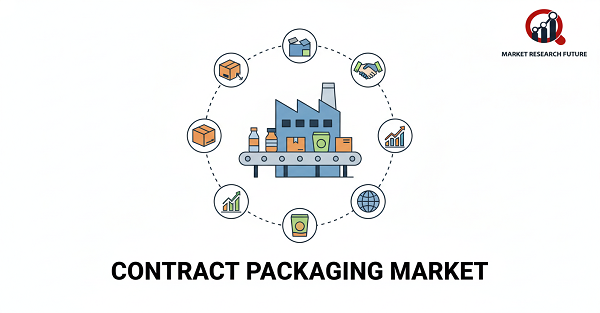Market Research Future (MRFR) has published a cooked research report on the “Contract Packaging Market” that contains information from 2025 to 2035.
The Contract Packaging Market is estimated to register a CAGR of 6.52% during the forecast period of 2025 to 2035.
MRFR recognizes the following companies as the key players in the Global Contract Packaging Market — WestRock (US), Sonoco Products Company (US), Mondi Group (GB), Smurfit Kappa (IE), ProAmpac (US), Graham Packaging Company (US), Berry Global (US), and Crown Holdings (US).

Contract Packaging Market Highlights
The Contract Packaging Market is accounted for to register a CAGR of 6.52% during the forecast period and is estimated to reach USD 119.24 Billion by 2035.
The Contract Packaging Market is going through big changes because of efforts to be more environmentally friendly, new technologies, and the rise of e-commerce. More and more businesses are hiring contract packagers to do their packaging work in order to save money, improve efficiency, and follow strict rules. Sustainability is still a big factor, as companies switch to more environmentally friendly materials and processes to meet customer needs and follow environmental rules.
The fast growth of online shopping has made the need for strong, customizable, and efficient packaging solutions even greater in order to keep products safe and improve the customer experience. New technologies like automation, robotics, and smart packaging are changing the way packaging works, making it more productive and giving it more freedom.
WestRock, Sonoco Products Company, and Mondi Group are some of the biggest companies that are working on new ways to make packaging more environmentally friendly and forming strategic partnerships to grow their businesses around the world.
As more and more people want personalized and eco-friendly products, companies are being forced to use advanced packaging solutions that not only keep goods safe but also show off their brand. This has made contract packaging an important part of global supply chains, especially in the consumer goods, food and drink, and pharmaceutical sectors.
Segment Analysis
The Contract Packaging Market has been segmented based on Packaging Type, End Use Industry, Contract Packaging Method, Material Type, and and Region.
Based on Packaging Type, the market has been segmented into Flexible Packaging, Rigid Packaging, Semi-Rigid Packaging, Pouches, Boxes. The Flexible Packaging segment dominated in 2024 due to its lightweight, cost-effective, and sustainable nature, while Rigid Packaging is projected to be the fastest-growing segment owing to increasing adoption of recyclable materials and its durability for high-protection applications.
Based on End Use Industry, the market is segmented into Food and Beverage, Pharmaceutical, Cosmetics, Consumer Goods, and Electronics. The Food and Beverage segment held the largest share in 2024 due to its diverse packaging needs and focus on convenience. Meanwhile, the Pharmaceutical segment is the fastest-growing, driven by strict regulatory standards and rising demand for specialized packaging for medicines and healthcare products.
Based on the Contract Packaging Method, the market includes Fill and Seal, Blister Packaging, Cartoning, Labeling, and Bundling. The Fill and Seal method dominates the market owing to its versatility and automation capabilities, while Blister Packaging is projected to grow rapidly due to its rising use in pharmaceuticals for tamper-evident and secure packaging.
Based on Material Type, the market is segmented into Plastic, Paperboard, Metal, Glass, and Composite. Plastic remains the dominant material due to its versatility and durability, while Paperboard is the fastest-growing segment, supported by growing consumer demand for recyclable and eco-friendly packaging options.
Region Analysis
By Region, the Contract Packaging Market is segmented into North America, Europe, Asia-Pacific, South America, and the Middle East & Africa. North America holds the largest share, accounting for about 40% of the global market. There are a lot of strong competitors in the market, including WestRock, Sonoco Products Company, and ProAmpac. These businesses are using cutting-edge technologies and new materials to meet the needs of a wide range of clients. The presence of large retail and e-commerce sectors drives demand even more, as companies look for ways to package their products more efficiently to improve the customer experience and cut down on waste.
Key Findings of the Study
- The Global Contract Packaging Market is expected to reach USD 119.24 Billion by 2035, at a CAGR of 6.52% during the forecast period.
- North America accounted for the largest market share, while Asia-Pacific emerged as the fastest-growing region.
- Based on Packaging Type, the Flexible Packaging segment dominated the market in 2024.
- Based on End Use Industry, the Food and Beverage segment held the largest market share in 2024.
- Key players include WestRock (US), Sonoco Products Company (US), Mondi Group (GB), Smurfit Kappa (IE), ProAmpac (US), Graham Packaging Company (US), Berry Global (US), and Crown Holdings (US).
Related Reports
https://www.marketresearchfuture.com/reports/contract-packaging-market-10970